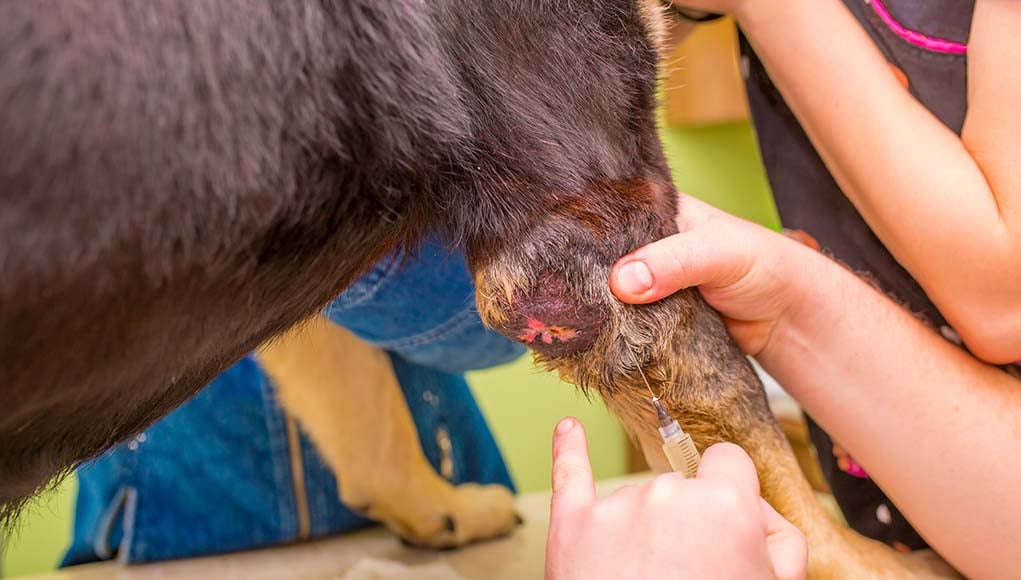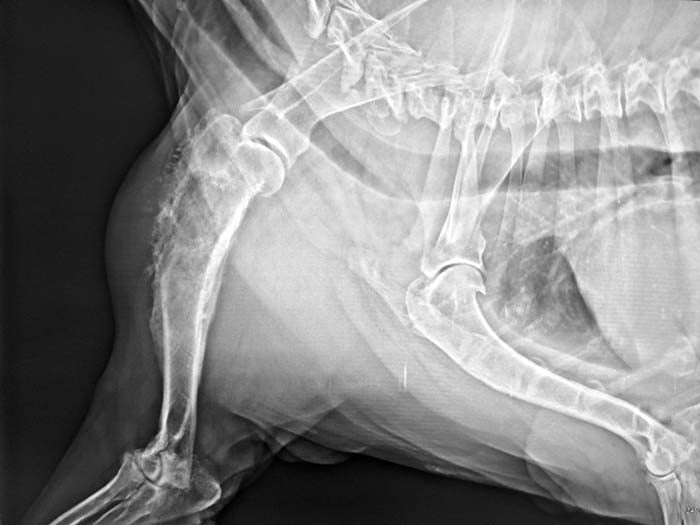Each twelvemonth approximately 8,000 to 10,000 dogsare name with osteosarcoma . Most frequently seen in big and giant breed dogs , this fast-growing bone Crab is known for speedy metastasis and , unfortunately , a poor overall prognosis . Here ’s everything you should know about osteogenic sarcoma in dogs and what your options are for bar , discussion and management .
What is Osteosarcoma?
Asarcomais a type of cancerous tumor that get ontogenesis in the osseous tissue , gristle , productive , brawn , blood line vessels , or other connective or supportive tissue . Since sarcoma can begin in various social structure and the type of sarcoma is refer after the area of growing , there are many dissimilar types of sarcoma tumors in dogs . Osteosarcoma is a sarcoma that specifically begin growth in the bone .
How Does Osteosarcoma in Dogs Grow?
salubrious cells in the body perform a show mapping and part in a methodical way of life to facilitate growth or to replace damaged or depleted cell . Cancerous cells , however , do n’t adopt the same methodical pattern of use and division .
Cancerous cells produce and divide at a much faster rate without dying off which make overpopulation of abnormal cells and prevents healthy cell from acting in a healthy way . As the number of abnormal cell increases rapidly , they can create a mass or “ tumour ” anywhere in the dog ’s body .
In the case of hotdog osteosarcoma , this abnormal cell growth take up piazza within the cells that are responsible for pearl growth and pearl resorption , or osteoblasts and osteoclasts . While the abnormal cells look standardised to the cells that are usually found in the bone , they are not structurally sound and as they push out the normal cells in the surface area , they replace levelheaded tissue paper with weaker , cancerous tissue .

Osteosarcoma in dogs can grow deep down of any of their pearl , but it is most often fancy in the carpus , knee , and shoulder of the front legs .
How Common is Dog Osteosarcoma?
According to the Animal Cancer Foundation , approximately 6 million dogs take in a new Cancer the Crab diagnosis each year . Approximately8,000 to 10,000(or 1.3 % to 1.6 % ) of those dog are diagnosed with osteogenic sarcoma .
Osteosarcoma can be recover in a number of mintage include dog-iron , cat , and humans , but in all specie , it seems to be a rather rare natural event . That said , osteosarcomais four times as common in dogsas it is in human race .
Large and elephantine breed wiener are those most often affected by osteosarcoma . It is gauge that almost 33 % of canine osteosarcoma diagnoses are made in dogs over 90lbs , whereas dogs under 30 lb invoice for less than 5 % of diagnoses . The median age of diagnosis is around8 old age oldyet a pocket-sized top of diagnosis are also made in dogsunder 3 years sure-enough .

X-ray image of swelling forelimb lameness dog show osteosarcoma bone tumor at foreleg.
Factors That May Predispose a Dog to Osteosarcoma
Researchers have discover a issue of traits that seem to be prevalent in dogs that develop osteogenic sarcoma , include heredity , stock , pace of growth , and sex .
Heredity has been shown to flirt one of the large roles in the development of dog osteogenic sarcoma . A late sketch on Scottish Deerhounds ( chosen because of their low variability in genic factors ) by Phillips and colleagues put out in Genomics ( Phillips et al . , 2007 ) bump that almost70 % of case of osteosarcoma were the result of inheritable factors . Of naturally , this is just one breed and one study , but standardized studies have also found a spectacular correlation between osteogenic sarcoma in dogs and the heritable factor .
The stock of a dog , too , can regulate their prevalence for an osteosarcoma diagnosing . While all breeds of domestic dog can uprise osteosarcoma , there are some breeds that seem to have a in high spirits relative incidence of this case of malignant neoplastic disease including theSaint Bernard , Great Dane , Irish Setter , Doberman Pinscher , Rottweiler , Scottish Deerhound , German Shepherd , and Golden Retriever .

X-ray image of swelling forelimb lameness dog show osteosarcoma bone tumor at foreleg.
Giant breed are more usually diagnosed with osteosarcoma , which is n’t surprising when a rapid rate of development has also been key out as another predisposing factor . Smaller breed dogs with amuch slower rateof maturation have been shown to have a significantly diminish prevalence of dogtooth osteosarcoma .
Gender is another predispose element when it total to diagnose osteosarcoma in pawl . survey have shown that Male are between20 % and 50 % more likelyto evolve osteosarcoma in comparison to distaff andiron .
ALSO READ:7 Hidden Toxins in Your House That’re Cancerous to Dogs

Anatomical location of primary bone tumors among 4 breeds of dogs [source].
Symptoms of Osteosarcoma in Dogs
symptom of osteogenic sarcoma in dog can be difficult to spot , but they mostly include :
Diagnosing Osteosarcoma in Dogs
Any of the symptoms above are not necessarily suggestive of osteosarcoma but they do warrant a visit to your veterinary surgeon for further testing . With as aggressive as osteosarcoma is , it is advisable to make an appointment with your vet as soon as you notice any symptom that may suggest osteosarcoma ( or any serious wellness concern for that issue ) .
The first thing your ex-serviceman will do during your appointment is aphysical exam . This will give them a better feel for the overall state of your dog ’s health as well as allow them to get a look at any presenting symptoms of osteogenic sarcoma in your wiener . This will also give up your vet to predominate out any other possible effort for your pet ’s symptoms .
Once your vet has performed a physical , they will take ablood and urine samplefor examination and order anx - ray .

If the XTC - light beam shows any areas of concern , your veterinarian will schedule a biopsy of the area and may govern aCT scan . CT imaging is able to give your veterinary a much clearer flick of any tumors in your weenie ’s limbs and is recommended because it also cater your dog ’s operating surgeon with more information so that they can better determine whether your dog is a candidate for surgical removal .
A biopsy of the affected area will be performed by either arrange your bounder underanesthesiaand convey a little fragment of bone or through a needle intake which only shoot cell from the affected field rather than a piece of the bone .
All of this testing will help your veterinarian to determine whether your dog has osteogenic sarcoma , whether the osteosarcoma has metastasized , and what stage your dog ’s osteosarcoma is .

Image source.
The Stages of Osteosarcoma
Osteosarcoma is graded like many types of malignant neoplastic disease in wiener using something call a“TNMG ” systemor “ tumor , node , metastasis , grade ” system . There are three microscope stage to this system and two substages .
In each of these stage , the substage “ a ” is used to refer to intramedullary lesion ( lesion that are present in the medullary cavity of the bone ) . Substage “ b ” is used to come to to osteosarcoma in dog that has go around outside of the medullary cavity of the bone but is confine topically .
Most diagnoses of osteosarcoma in dogs are made atstage II - b.

Treatment Options for Osteosarcoma in Dogs
While there are treatments usable for osteosarcoma in dogs , these treatments are broadly speaking only able to treat symptoms and make your dearie more comfortable . In most case , eye tooth osteosarcoma is not seen as a curable disease .
Thetreatment of choicein dogs with osteosarcoma in the limbs is to have the tumour removed surgically . Surgical removal may or may not includeamputation . Amputation is frequently the best option since to spare the tree branch and only dispatch the tumor requires the neoplasm to be in a specific location for complete removal .
Limb - sparing surgery also demand much more post - operative care and price since it usually requires reconstruction of a segment of the os which leave behind the possibleness for serious contagion and unsuccessful person of the reconstructive memory implant . tree branch - sparing surgery also has a15 % to 20 % rate of tumor return .
Surgical interference alone is usually not recommend , because it leave a shorter median survival time than dogs that receive combining treatment .
agree to the science article on PubMed linked above , “ What do we bang about canine osteogenic sarcoma treatment ? ” by M. Szewczyk , R. Lechowski , and K. Zabielska , information collected on osteosarcoma treatment in dog between 1986 and 2003 show that dogs with metastasis of their osteosarcoma to local lymph nodes had an averagesurvival time of 48 daysafter their diagnosis with surgery alone . Dogs without lymph node metastasis had an averagesurvival meter of 318 twenty-four hour period .
A second intervention approach to osteosarcoma indogs is to compound the surgical method of tumor removal with chemotherapy . In one study cited by the article we referenced above , wiener with osteosarcoma that had their amputation followed by four cycle of chemotherapy ( with carboplatin ) had an averagesurvival time of 307 daysversus 138 twenty-four hour period for those dog that had amputation alone . Other chemotherapy drug studieshave also been conducted with similar results .
Studies have also been conducted in which dog received combination chemotherapy treatment following amputation and while result seem to be mixed , they still fend for the economic consumption of chemotherapy in sustain life expectancy situation - amputation in osteosarcoma .
Radiation therapy is usually used for palliative aid in dogs with osteogenic sarcoma because it reduces pain in the neck ministration and provides a long survival time . Studies have prove that by combining operative interposition with chemotherapy and radiation therapy seems to be the most effective method of deal frank with osteosarcoma .
One study found that the average survival time in detent receiving a combination of chemotherapy and radiation therapy following operative interventionwas 307 days . regrettably , since radiation therapy is expensive , is not always accessible , and requires a dog to be under anesthesia , it is not as widely utilized as it could be for managing osteosarcoma in dogs or other diseases .
The Importance of At-Home Care
In addition to whatever treatment approach you and your dog-iron ’s vet settle upon for your pooch , it ’s important that you do n’t blank out about the importance of at - home care which can be very helpful for managing osteosarcoma in dogs . There are many things that you could do at home to make your dearie more comfortable and to sail the days ahead .
It may be a unmanageable fourth dimension when dealing with osteosarcoma in firedog , but there ’s help and support available for pet owners . you may find more great tips on at - home care for dogs with any types of genus Cancer onCanineCancerAwareness.org .
READ NEXT : Bone Crab in Dogs – What It Means for Your Dog and What to Do